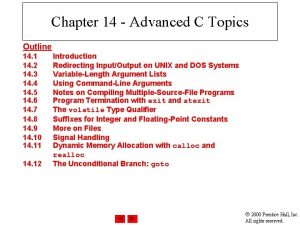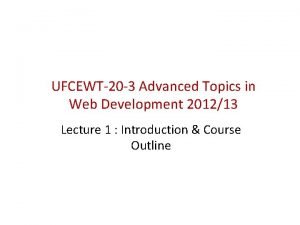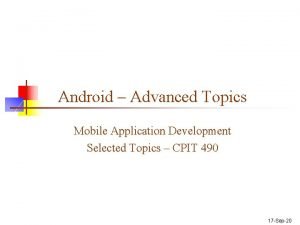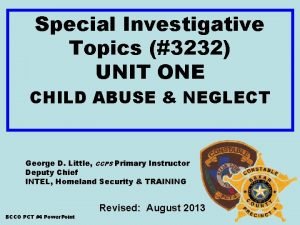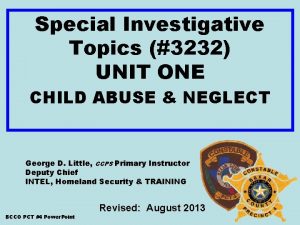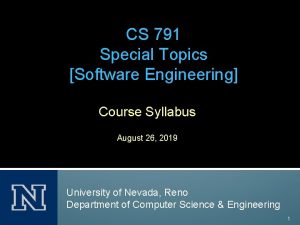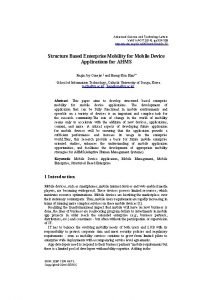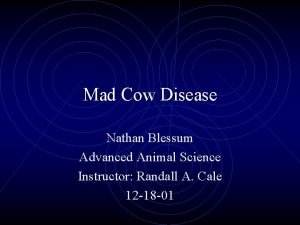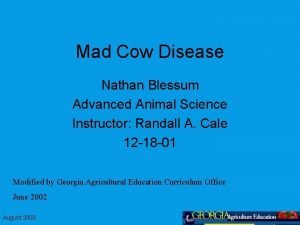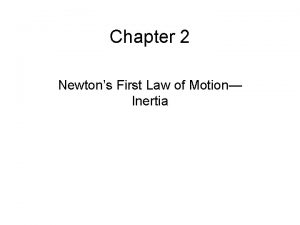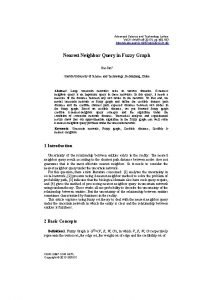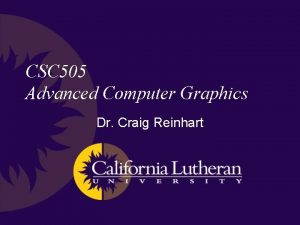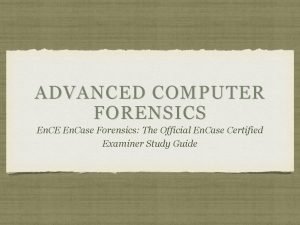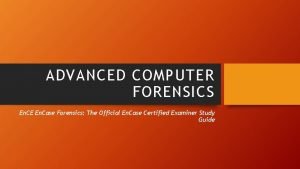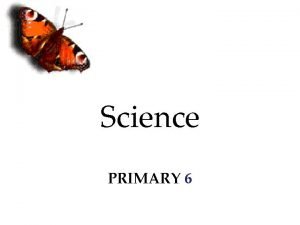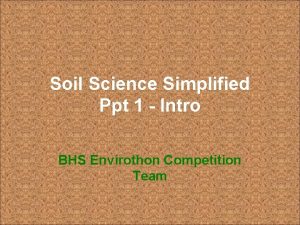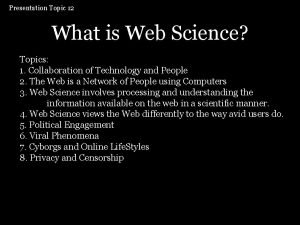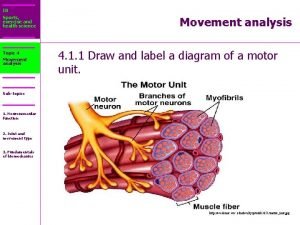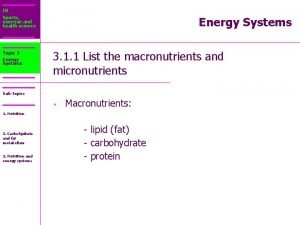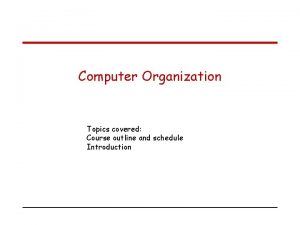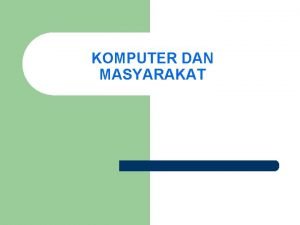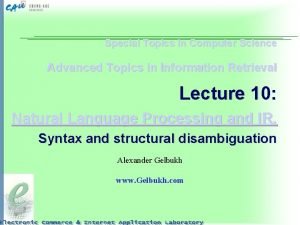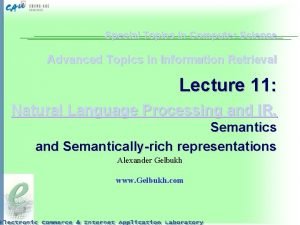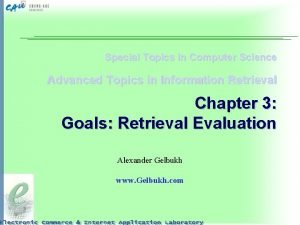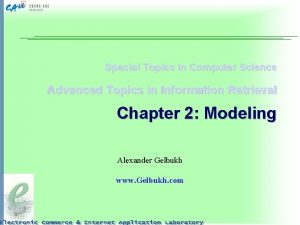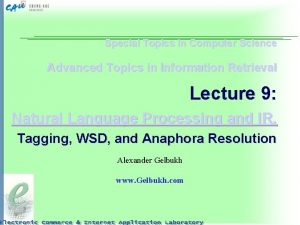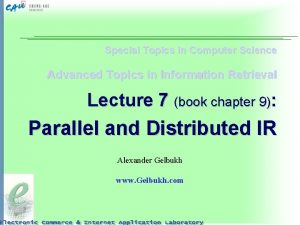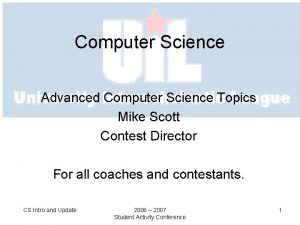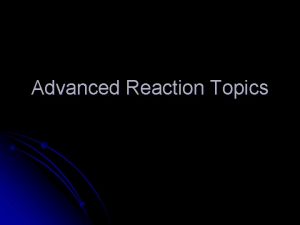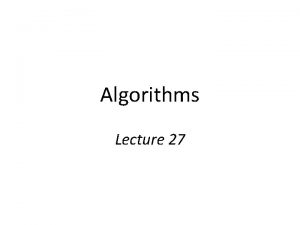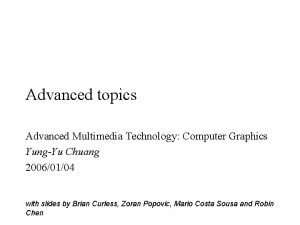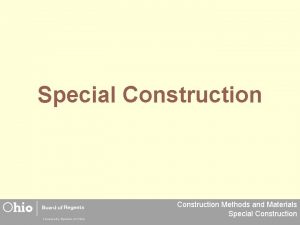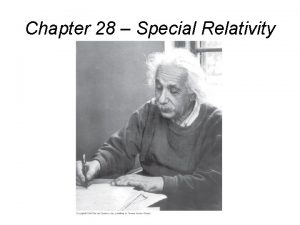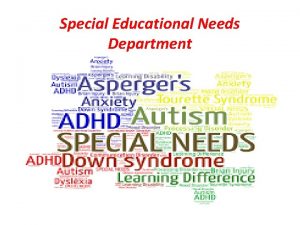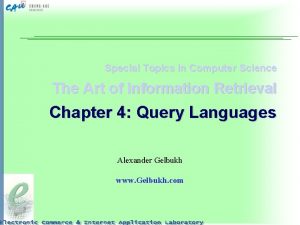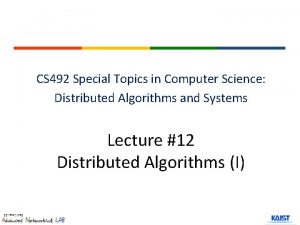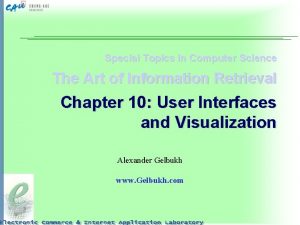Special Topics in Computer Science Advanced Topics in





























- Slides: 29

Special Topics in Computer Science Advanced Topics in Information Retrieval Lecture 5 (book chapter 11): Multimedia IR: Models and Languages Alexander Gelbukh www. Gelbukh. com

Previous Chapter: Conclusions q Inverted files seem to be the best option q Other structures are good for specific cases o Genetic databases q Sequential searching is an integral part of many indexing-based search techniques o Many methods to improve sequential searching q Compression can be integrated with search 2

Previous Chapter: Research topics q Perhaps, new details in integration of compression and search q “Linguistic” indexing: allowing linguistic variations o Search in plural or only singular o Search with or without synonyms 3

Motivation q Applications: o o office, CAD, medical, Internet q Example: o Artists sings a melody and sees all the songs with similar melody 4

What’s different q Different from text IR: o o Structure of data is more complex. Efficiency is an issue Using of metadata Characteristics of multimedia data Operations to be performed q Aspects: o Data modeling: Extract and maintain the features of objects o Data retrieval: based not only on description but on content 5

Retrieval process q Query specification o fuzzy predicates: similar to o content predicates: images containing an apple o data type predicates: video, . . . q Query processing and optimization o Parsed, compiled, optimized for order of execution o Problem: many data types, different processing for each q Answer o Relevance: similarity to query q Iteration o Bad quality, so need to refine 6

Modeling

Data modeling q To model is to simplify, in order to make manageable. “We will represent an image as. . . ” o From the user’s point of view o From the system’s point of view (technically) q A problem: very large storage size. Modeling needed q Objects are represented as feature vectors o Images / Video: shape. House, car, . . . o Sound: style. Music: Merry, sad, . . . q Features are defined directly or by comparison o Degree of certainty is stored 8

Multimedia support in commercial DBMSs (1999) q Variable length data. o Non-standard o Different and usually very limited sets of operations q SQL 3: o provides user-extensible data types o Object-oriented o Implemented partially in many systems q Example: data blades of Informix o Content-based functions on text and images o E. g. : date = 1997 AND contains (car) 9

Spatial data types q q q Informix: 2 D, 3 D data blades Boxes, vectors, . . . Operations: intersect, contains, center, . . . Text: contain. Words, . . Supports query images by content 10

Example: MULTOS q Multimedia document server q Documents are described by: o o logical structure: title, into, chapter, . . . layout structure: pages, frames, . . . conceptual structure: allows content-based queries Docs similar in conceptual structures are grouped into conceptual types o Example: Generic_Letter 11

Example of conceptual structure. . . 12

. . . continued 13

Image data in MULTOS q Analysis o low level: detect objects and positions o high level: image interpretation q Result of analysis: o description of objects found and their classes o certainty values q Indices are used for fast access to this info o Object index. Includes pointers to objects and certainty values o Cluster index, with fuzzy clusters of similar images 14

Internet q q q How Google does it? No image processing. Textual context! File names, nearby words Distance from image to words “give me images with flower in the file name or near the image” 15

Languages

Query languages q As a query, either a description of the object or an example object is submitted o “show me images similar to this one” o in what respects similar? ! q Exact match is inadequate. Additional means are needed q Content is not a single feature 17

What defines query language q Interface. How to enter the query q Types of conditions to specify q Handling of uncertainty, proximity, weights 18

Interface q Browsing and navigation q Search: description or query by example q Query by example: o specify what features are important. Give me all houses with similar shape but different colors o Libraries of examples can be provided 19

Conditions. . . q Attribute predicates o structured content – the predefined types extracted beforehand o Exact match. E. g. : size, type (video, audio, . . . ) q Structural predicates o structure: title, sections, . . . o metadata are used. Find objects containing an image and a video clip q Semantic predicates o unrestricted content. o Find all red houses: red = ? , house = ? Fuzzy 20

. . . conditions q Predicates o Spatial: contain, intersect, is contained in, is adjacent to. . . o Temporal: Find audio where first politics and then economy is discussed o Spatial and temporal predicates can be combined: Find clips where the logo disappears and then a graph appears at the same place q A predicate can be applied to a part of document o As path expressions in OO databases 21

Uncertainty, proximity, weights q Similarity function q The user can assign importance weights to individual predicates in a complex query q This gives ranking, as in text IR q The same models can be used, e. g. , probabilistic model 22

Examples of query languages: SQL 3 q Functions and stored procedures: user-defined data manipulation q Active database support: database reacts on the events, not only commands. This enforces integrity constraints q Good news: rather standard q Bad news: no ranking supported! q Effort to integrate SQL 3 with IR techniques. SQL MM Full Text and other similar languages 23

. . . examples: MULTOS q One of design goals: easy navigation o Paths are supported q Identification of components by type, not by position o All images in the document, not the image in 3 rd chapter q Types of predicates: o on data attributes, on textual components, on images (image type, objects contained, . . . ) q Example: 24

MULTOS example 25

Another example of MULTOS 26

Research topics q How similarity function can be defined? q What features of images (video, sound) there are? q How to better specify the importance of individual features? (Give me similar houses: similar = size? color? strructure? Architectural style? ) q How to determine the objects in an image? q Integration with DBMSs and SQL for fast access and rich semantics o Integration with XML o Ranking: by similarity, taking into account history, profile 27

Conclusions q Basically, images are handled as text described them o Namely, feature vectors (or feature hierarchies) o Context can be used when available to determine features q Also, queries by example are common q From the point of view of DBMS, integration with IR and multimedia-specific techniques is needed o Object-oriented technology is adequate 28

Thank you! Till ? ? , 6 pm 29
 Advanced topics in computer science
Advanced topics in computer science What s your favorite subject
What s your favorite subject Cs 527 uiuc
Cs 527 uiuc Angular guard naming convention
Angular guard naming convention Advanced topics in angular
Advanced topics in angular Advanced c topics
Advanced c topics Advanced topics in web development
Advanced topics in web development Android advanced topics
Android advanced topics Special investigative topics 3232 quizlet
Special investigative topics 3232 quizlet Special investigative topics 3232
Special investigative topics 3232 Special topics in software engineering
Special topics in software engineering Advanced higher computing
Advanced higher computing Advanced science and technology letters
Advanced science and technology letters Advanced animal science
Advanced animal science Advanced animal science
Advanced animal science When burl and paul stand on the scaffold
When burl and paul stand on the scaffold Pharma degree
Pharma degree Advanced science and technology letters
Advanced science and technology letters Review of fundamentals of cpu
Review of fundamentals of cpu Craig reinhart
Craig reinhart Advanced computer forensics
Advanced computer forensics Fastbloc
Fastbloc Primary 6 syllabus
Primary 6 syllabus Soil colloids ppt
Soil colloids ppt Science presentation topics
Science presentation topics Ib sports, exercise and health science topics
Ib sports, exercise and health science topics Ib sports exercise and health science
Ib sports exercise and health science Computer organization topics
Computer organization topics Computer and society topics
Computer and society topics Natural vs social science
Natural vs social science





